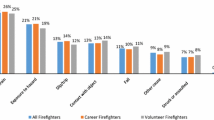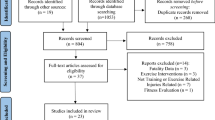Abstract
Firefighting remains a dangerous profession. The objective of this study was to compare injury rates among career and volunteer fire departments internationally. Methods: Injury and staffing data were collected for 2004–2009. All reported, lost-time, and activity-specific injury rates were calculated for fireground, medical, training and physical exercise activities. Injury rates were also adjusted for number of fireground and medical responses, and average annual training hours. Injury rates were generally higher in the U.S. than in Commonwealth nation and Japanese fire departments. Lost-time injury rates varied markedly among fire departments, from 0.6 (95% CI 0.4–0.9) to 23.5 (95% CI 22.4–22.7) injuries per 100 firefighters per year. The greatest pair-wise differences in lost-time injury rates were seen in the fireground and medical call activities, and these differences persisted when the rates were adjusted by the number of firefighters responding to fireground and medical incidents, respectively. Injury rates vary substantially across fire departments, suggesting that substantial improvements could result from adoption of more optimal health and safety approaches.


Similar content being viewed by others
References
Studnek JR, Ferketich A, Mac Crawford (2007) On the job illness and injury resulting in lost work time among a national cohort of emergency medical service professionals. Am J Ind Med 50:921–931
Fabio A, Ta M, Strotmeyer S, Li W, Schmidt E (2002) Incident-level risk factors for firefighter injuries at structural fires. J Occup Environ Med 44:1059–1063
Fosbroke DE, Kisner SM, Myers JR (1997) Working lifetime risk of occupational fatal injury. Am J Ind Med 31:459–467
Karter MJ, Molis JL (2010) U.S. Firefighter Injuries—2010. National Fire Protection Association, Fire Analysis and Research Division, Quincy, MA
Poplin GS, Harris RB, Pollack K, Peate W, Burgess JL (2011) Beyond the fireground: injuries in the fire service. Inj Prev. doi:10.1136/injuryprev-2011-040149
Robens Committee (1972) Committee of inquiry into health and safety at work. Cmnd HMSO, London
AS/NZS ISO 31000 (2009) Risk management—principles and guidelines. Standards Australia, Australia. ISBN: 0-7337-9289-8.
Japan Industrial Safety and Health Association, English translation of Guidelines on Occupational Safety and Health Management Systems, Ministry of Labour Notification No. 53. http://www.jisha.or.jp/english/pdf/Ministry_of_Labor,Health_OSHMS_Guideline.pdf. Accessed 13 Aug 2012
Poplin GS, Miller HB, Ranger-Moore J, Bofinger CM, Kurzius-Spencer M, Harris RB, Burgess JL (2008) An international evaluation of injury rates in coal mining: a comparison of risk and compliance based regulatory approaches. Saf Sci 46:1196–1204
Centre of Fire Statistics of CTIF—World Fire Statistics 2006—Report No. 11 (2006) http://www.ctif.org/IMG/pdf/CTIF_report11_world_fire_statistics_2006-2.pdf. Accessed 13 Aug 2012
Volinn E, Nishikitani M, Volinn W, Nakamura Y, Yano E (2005) Back pain claim rates in Japan and the United States: framing the puzzle. Spine 30:697–704
Maizlish NA (ed) (2000) Workplace health surveillance: an action-oriented approach. Oxford University Press, New York
Karter MJ (2012) Patterns of firefighter fireground injuries. National Fire Protection Association, Fire Analysis and Research Division. Quincy, MA
Lavender SA, Conrad KM, Reichelt PA, Johnson PW, Meyer FT (2003) Biomechanical analyses of paramedics simulating frequently performed strenuous work tasks. Appl Ergon 31:167–177
Chow DHK, Cheng IYW, Holmes AD, Evans JH. Muscular and centre of pressure response to sudden release of load in symmetric and asymmetric stoop lifting tasks. Appl Ergon 36:13–24
Aherns M (2007) Trends and patterns of U.S. fire losses. National Fire Protection Association, Fire Analysis and Research Division, Quincy, MA
Karter MJ (2011) Fire loss in the United States during 2010. National Fire Protection Association, Fire Analysis and Research Division, Quincy, MA
Hilyer JC, Brown KC, Sirles AT, Peoples L (1990) A flexibility intervention to reduce the incidence and severity of joint injuries among municipal firefighters. J Occup Environ Med 32:631–637
Nelson A, Matz M, Chen FF, Sidharthan K, Lloyd J, Fragala G (2006) Development and evaluation of a multifaceted ergonomics program to prevent injuries associated with patient handling tasks. Int J Nurs Stud 43:717–733
Peate WF, Bates G, Lunda K, Francis S, Bellamy K (2007) Core strength: a new model for injury prediction and prevention. J Occup Med Toxicol 2:3
Leffer M, Grizzell T (2010) Implementation of a physician-oriented wellness regime (POWR) enforcing the 2007 NFPA standard 1582: injury rate reduction and associated cost savings. J Occup Environ Med 52:336–339
Moore-Merrill L, Zhou A, McDonald-Valentine S, Goldstein R, Slocum C (2008) Contributing factors to firefighter line-f-duty injury in metropolitan fire departments in the United States. International Association of Fire Fighters. August
Courtney TK, Burdorf A, Sorock GS, Herrick RF (1997) Methodological challenges to the study of occupational injury—an international epidemiology workshop. Am J Ind Med 32:103–105
Stout N, Frommer M, Harrison (1990) Comparison of work-related fatality surveillance in the U.S.A. and Australia. J Occup Accid 13:195–211
Acknowledgments
We wish to thank the partnering fire department administrations and unions for their willingness to share their expertise and data. In addition, we would like to thank the Metro Chiefs, in particular Russ Sanders, and the International Association of Fire Firefighters for their support of the study. Casey Grant and the panel members of the Fire Protection Research Foundation of the National Fire Protection Association provided essential review of the study design, results and interpretation.
Funding
This study was supported by FEMA Assistance to Firefighters Grant Program—Fire Prevention and Safety grant # EMW-2008-FP-01536.
Conflict of interest
None.
Author information
Authors and Affiliations
Corresponding author
Rights and permissions
About this article
Cite this article
Burgess, J.L., Duncan, M., Mallett, J. et al. International Comparison of Fire Department Injuries. Fire Technol 50, 1043–1059 (2014). https://doi.org/10.1007/s10694-013-0340-y
Received:
Accepted:
Published:
Issue Date:
DOI: https://doi.org/10.1007/s10694-013-0340-y




